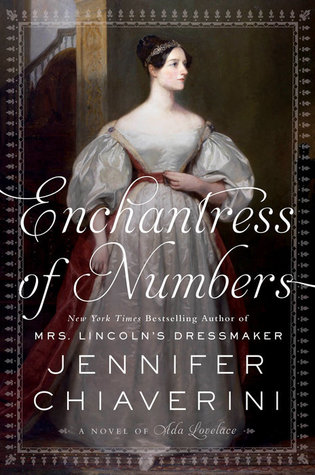Enchantress of Numbers: A Novel of Ada Lovelace
- By Jennifer Chiaverini
- Dutton
- 448 pp.
- Reviewed by Amanda Skenandore
- January 2, 2018
A well-researched, imaginative portrait of Lord Byron’s mathematician daughter.

I confess, I had not heard of Ada Byron King, Countess of Lovelace, who is viewed by many scholars as the first computer programmer, before picking up Jennifer Chiaverini’s latest book. But Ada’s travails and accomplishments as told in Enchantress of Numbers are both fascinating and enduringly relevant.
Ada was born in England in 1815 at the tail end of the Industrial Revolution, and witnessed in her short lifetime (only 36 years) numerous scientific and technological advancements. These inventions and discoveries, combined with her own prodigious intellect, provided the fodder for her own “Great Work,” a mathematical algorithm for the Analytical Engine, one of the world’s earliest conceptualized computers.
She achieved this feat despite her well-meaning but overbearing mother, Anne Milbanke, and the shadow of fame and infamy cast by her father, Lord Byron, foremost of England’s Romantic poets. More constraining still was the ubiquitous belief that advanced mathematics required a “very great tension of the mind…beyond the strength of a woman’s physical power.”
Though less widely held, shades of this idea are still batted around today by university presidents and Silicon Valley engineers, making Ada’s struggle timely and relatable nearly 200 years later.
Against this turbulent backdrop, Chiaverini composes the tableaux of Ada’s life, and I found it a joy to witness on the page. Though Chiaverini’s research was clearly voluminous, she weaves historical details into the prose with a light, skillful hand. Ada’s world of 19th-century England is vivid, and never tedious or obtuse in its description.
The scientific and mathematical principles over which Ada labors are likewise presented in a way entirely lucid and palatable, even to someone like me, who suffered through calculus with more frustration than comprehension.
The novel’s greatest strength, however, lies in the expertly crafted characters of Ada and her mother. The prologue supplies the backstory of Lord and Lady Byron’s short, caustic marriage before Lady Byron leaves the famous poet with 6-week-old Ada in tow, never to see her father again. Though the book shifts in chapter one to young Ada’s perspective, I continued to empathize with her mother even as my affinity for Ada grew.
This, I must believe, was Chiaverini’s design, as it stirred me to examine the way we never truly see our parents — especially through the self-centered haze of youth — as fully formed beings, subject to all the hope and heartbreak life entails. Both Ada and Anne rise above listless, corset-bound tropes, humanized by their obsessions, jealousies, and longings.
Chiaverini also dodges other tropes common to historical novels. Midway through the story, Ada proclaims, “If I were the sort of young lady who swooned, I probably would have done so at that moment.” The cause of her disquiet, however, is not some eligible bachelor in possession of a great fortune, but the prospect of meeting her idol, Mary Somerville, the leading female mathematician of the day.
While there are certainly elements of romance and courtly intrigue throughout, it is the Difference Engine and its successor, the Analytic Engine, with their numbers and cogs and scientific potential that truly captivate Ada. Whether art informs life or the other way around, I found it noteworthy and refreshing that the story’s heroine had such a deep and rich interior landscape.
The book does fall short in one regard. It reads like an autobiography. Indeed, Chiaverini intentionally frames it that way, capturing Ada’s life year-by-year from infancy until just before her death. In doing so, she gives the reader a more complete picture of the joys and tribulations that shape Ada’s character, but at the expense of story.
I didn’t feel the pull of ever-deepening conflict building to a defined, character-altering climax. While there are mini arcs like this throughout, and several themes linking them together, I read on not because the circumstances of the story compelled me, but rather because Ada’s precocious personality did.
In the greatest of novels, plot and character work in concert, even if one predominates. Here, plot seemed to languish in service of chronology. But this is only a slight tarnish on an otherwise sparkling book.
In her acknowledgements, Chiaverini says, “One of the greatest joys of writing historical fiction is the opportunity to bring little-known or forgotten historical figures to the forefront of the story.”
In this she succeeds masterfully. The life of Ada Byron King well deserves this spotlight, not only for her contribution to mathematics and computing, but as an example of hope and fortitude. She is not only a true enchantress of numbers, but a reminder of how far society has progressed and how far it has yet to go.
Amanda Skenandore is an historical-fiction author and infection-control nurse. Her debut novel, Between Earth and Sky, comes out from Kensington Publishing in April 2018. When she’s not writing or chasing germs, Amanda gardens and volunteers with her local writers’ group. She lives in Las Vegas with her husband and their pet turtle, Lenore.

